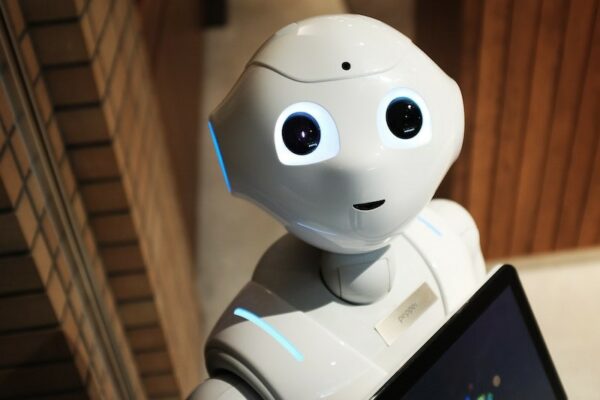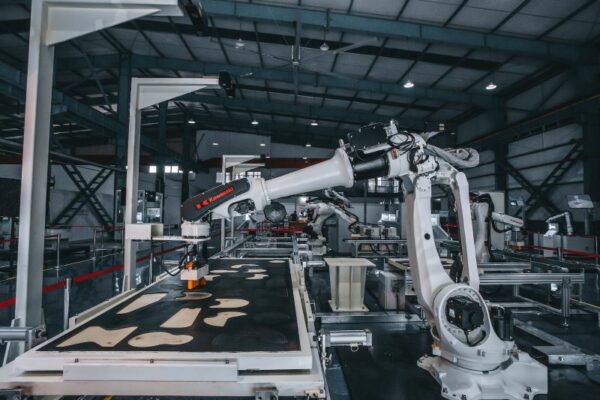RESEARCH EXCELLENCE INITIATIVE
FREEDOM OF RESEARCH – SCIENCE FOR THE FUTURE
‘Freedom of Research – Science for the Future’ series consists of articles, interviews and short videos presenting research conducted by the winners of the ‘Freedom of Research’ call for proposals
Mateusz Paliga, PhD
Cobot — human’s special co-worker
| Olimpia Orządała |
Collaborative robots (cobots), which accompany humans, are a fairly common technological solution that has been used in industry for quite some time. They are treated as co-workers rather than tools used to carry out tasks. Mateusz Paliga, PhD, from the Institute of Psychology of the University of Silesia in Katowice, conducted a nationwide study on the seamless interaction between humans and cobots as part of the first edition of the Research Excellence Initiative’s ’Freedom of Research’ call for proposals.

Olimpia Orządaała: Let us start from the beginning. What are cobots and what do they do?
Mateusz Paliga, PhD: Cobots are a special type of robots. The word itself comes from the phrase ‘collaborative robots’. Before cobots were developed and implemented, people working with robots did not share a common space with them due to their enormous size, weight, and possible dangers. They were separated from the workers with, e.g. nets or laser systems, beyond which the robots would automatically stop. Cobots, however, share the space with people. A human and a cobot can work together on a single task, exchanging objects, or bolting something together. The worker is in direct contact with the robot, which was not the case before.
O.O.: What tasks are cobots typically used for? Is it manufacturing?
M.P.: Yes, for manufacturing tasks, although they are also used in medicine. On the one hand, they are helpful in spaces involving certain risks, which are dangerous to be in due to physical conditions. On the other hand, they can be used for tasks that are monotonous or even boring.
O.O.: Undoubtedly, cobots make human work easier. And what are the disadvantages of working with a robot?
M.P.: There are several disadvantages. It has been discovered that if the speed of the robot is increased or the distance between the human and the cobot is significantly reduced, then the conditions may turn quite stressful — both physiologically and psychologically. The role of the worker is also changing — the industry is no longer just about physical fitness, but also about using one’s cognitive abilities. Observation is important — checking that the machine is working well, and being ready to react appropriately when the robot starts to behave in an unpredictable way. I think this is interesting not only from an industrial perspective. It has been found, on the one hand, that people are fascinated by robots that function autonomously. What intrigues us most are humanoid robots. Sophia, programmed to talk freely about any topic, or Ameca, which imitates emotions and facial expressions very well, are good examples. They’re fascinating to watch and at the same time a little scary. There are other examples, such as Atlas, which was the first robot to maintain an upright posture very well. This is, in fact, the first time that a machine has been called a robo sapiens due to its upright posture. On the other hand, it has been discovered that when autonomous machines appear, humans perceive them as intrusive and threatening…
O.O.: … as those that could take over humanity?
M.P.: Exactly. Culture, religion and the media have created a figure of a human who has decisive power and is at the top of the hierarchy of the world. And all of a sudden there is a machine that can decide, does it better, makes fewer mistakes, and doesn’t get tired. People noticed that something that was so typically human was suddenly becoming inhuman. Robots have taken away a little bit of that uniqueness from us. So I think that it’s a big challenge to teach people to work with an object that is not human, but at the same time can make decisions and is rarely wrong.

O.O.: Some time ago, one of the online news services published footage showing an experiment that was carried out at the Copernicus Science Centre, involving the Babyclon robot, which is remarkably similar to a baby. The experiment tested the reaction of different people — some were fascinated, and others interrupted the experiment and walked away in horror. It was very interesting.
M.P.: Agreed. There is a concept called uncanny valley. According to this view, one analyses the feelings produced by contact with a robot depending on how similar this machine is to a human being. Industrial robots, cleaning robots, or toy robots do not make humans uncomfortable. The more similar they are to a creature or a human, the more comfort they induce. But at a certain point, when the robot starts to become almost human-like, this valley sets in. At first, we are fascinated…
O.O.: …and then the enthusiasm dies down.
M.P.: Yes. It’s interesting that in this valley there are not only humanoid robots but also, for example, zombies from the movies. Some people say it’s not exactly uncanny valley, it’s an uncanny cliff, because so far all the robots are going up and down, and none of them are coming back up [laughs]. I think the relationship with robotic objects is very emotionally charged. On the one hand, there are positive emotions because, for example, an industrial robot takes some weight off a human being, but on the other hand, there are also negative emotions. People feel that robots will replace them. Many people use, for example, the touch screens of the self-service machines in McDonald’s or KFC, which perfectly replace the cashier. The very idea of robots replacing workers is not new. In the case of so-called low-skill jobs that do not require complex or specific competencies, humans will be replaced by robots. So, I am not surprised that when robots are introduced into a factory and set up at the production line, workers experience anxiety.
O.O.: What are the benefits of implementing cobots in companies?
M.P.: On the one hand, there is a certain amount of relief, especially physical relief, the need to work in difficult conditions decreases. On the other hand, when unfamiliar equipment appears, humans are required to develop new skills. The question is whether everyone is ready to learn how to work with technology. The implementation of cobots can also be considered at an organisational level. Their use is a sign that the factory is developing, following trends, and introducing modern technology. In addition, since the robots help with the work, the company that implements them cares about the employees, improving the working environment.
O.O.: The research you conducted as part of the Research Excellence Initiative was on the interaction between a cobot and a human.
M.P.: There is an increasing amount of such research on human-cobot cooperation. However, it is often difficult to put the results together because researchers use different concepts and theoretical or methodological approaches. I decided to use what is well-known in work and organisational psychology. I transferred the things we know about humans to robots. I was most interested in the fluidity of the interaction between a human and a cobot. I assumed it was a highly coordinated cooperation leading to a synergistic team of a human and a robot performing tasks together. I reasoned that it was possible to approach this interaction in exactly the same way as one approaches human-to-human interaction. Four elements can be examined here. Firstly, I examined the contribution of the worker — how they engage with the robot. Some people argue that it is human input and control that is the greatest guarantor of the safety and productivity of such a team. Secondly, I focused on emotion, as human trust in the robot is considered to be one of the most important factors. Thirdly, I looked at how well the robot fulfils its duties and whether it is reliable and predictable. Fourthly, I looked at whether, in fact, the human and the robot are performing their jobs well as a collective entity.

O.O.: What conclusions did you draw from this research?
M.P.: I found that working with cobots, according to Robert Karasek’s theory, falls under the so-called active work. Although people feel the pressure associated with changing from executive to managerial work, they perform well and are productive. I think this is due to the fluidity of the interaction. Certain predictability, trust, and positive emotions that occur give people a sense of control. I have also found that the smooth interaction between a human and a robot results in increased work engagement. The cobots’ co-workers want to be engaged in their work, and they experience positive cognitive-affective states that make them do their job well.
O.O.: How was the research conducted?
M.P.: It was a survey carried out by an external company on the basis of a questionnaire prepared by me. A total of 200 people completed the questionnaire. This is a very good result because access to cobot’s co-workers is difficult. Surveys are usually conducted on small groups or involve students or people who do not work with robots on a daily basis. The question then is whether the conclusions drawn apply to an actual person working with cobots. In the article I published, the editor noted that the study is conducted on a relatively large sample of people who actually work with robots. The conclusions are drawn from real life, not from the lab.
O.O.: What ideas do you have for further research?
M.P.: I would like to further analyse the fluidity of human-robot cooperation. wonder whether this seamless interaction is related to employee satisfaction and whether it helps them cope with their workload. I’m also interested in whether a person’s personality makes a difference in the way they interact with a robot.
O.O.: Thank you for the interview.
The results of the research conducted by Mateusz Paliga, PhD, on human-cobot interaction have been published in the article ‘Human-cobot interaction fluency and cobot operators’ job performance. The mediating role of work engagement: A survey’ in the Robotics and Autonomous Systems journal.





